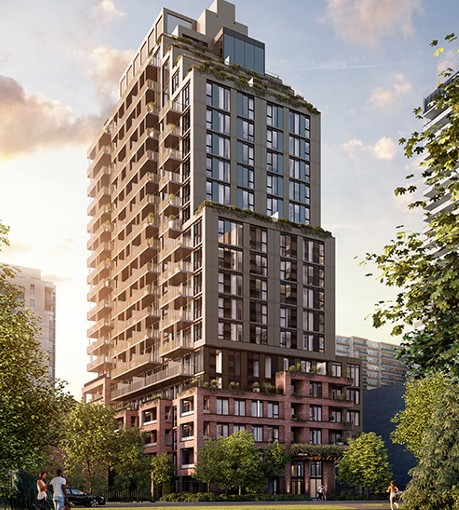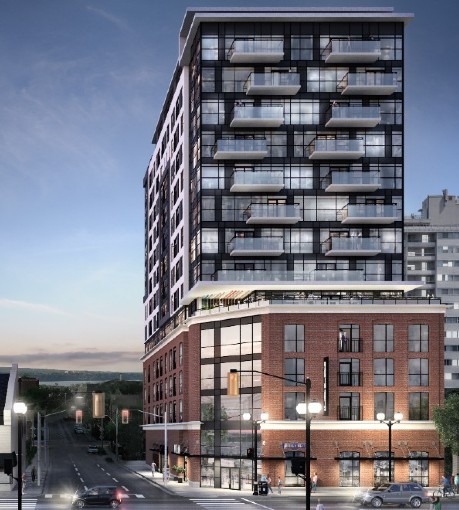Urbanites living in two up-and-coming condos won’t have to escape their homes for fresh air and water. In an industry hesitant to embrace new technologies, some developers are bringing smart health innovations to the forefront of their amenity offerings.
The team behind AKRA Living—a retreat-like condo rising 22 storeys near Toronto’s busy intersection of Yonge and Eglinton—is filling the high-rise with clean air technology, including COVID-fighting devices that aren’t prevalent in multi-residential living.
“In a post-pandemic world, wellness and access to high-quality fresh air is no longer a nice-to-have; it’s a feature that residents and condo purchasers will actively seek out,” says Jesse Speigel, senior vice-president at Curated Properties. “I’d be surprised if we didn’t see more widespread adoption.”
The non-profit Global Wellness Institute measured the wellness industry at $4.4 trillion in 2020 and predicts it will reach $7 trillion by 2025. Wellness real estate is currently estimated at $245 billion and growing. Canada is now second in the world when it comes to growth, as the market ballooned 240 per cent from 2017 to 2020.
Projects like AKRA are fuelling momentum. The 211 suites will feature increasingly popular technologies: fan coil units will be fitted with energy recovery ventilators for dedicated fresh air supply, and high-efficiency HEPA and MERV filters. Heat recovery ventilation units installed in the common areas will help establish a fresh air supply for specific amenity spaces.

AKRA Living will be a residential retreat featuring communal herbal and Zen gardens and a dedicated spa for health and wellbeing.
A more novel addition that Curated Properties actively sought out with the pandemic in mind is Aura Air, a system developed in Israel and currently installed at the country’s Sheba Medical Center. The technology was clinically proven to eradicate more than 99 per cent of viruses, including COVID-19 particles through six stages of air purification and disinfection that includes UV-C LEDs.
There aren’t such devices on the market being used in Ontario’s multi-residential spaces as it stands. “We’re quite excited about the technology and keen to build it into the design of our high-traffic common areas,” says Speigel.
“People are still a bit hesitant to be mixing with other residents in common areas unmasked—that behaviour will likely persist,” he predicts. “As developers, it’s our responsibility to future-proof these buildings as best we can and respond to residents’ wants and needs.”
Unchartered Waters
About an hour away by car, in Hamilton, Ontario, there’s a growing population looking for healthy spaces to live among the brick-and-beam aesthetic of the city’s industrial past.
On the former CHIQ radio station site, the Radio Arts condo is bringing such a place forward. Vernon Shaw, founder and president of Canlight Realty Corporation, hopes to incorporate as much as possible inside the 14-storey building.
“It’s a very budget-conscious business and you have to look at where every dollar goes, but I like the idea of trying to provide a low-cost, healthy living environment,” he says, alluding to some anticipated amenities.

Health is at the forefront of the Radio Arts project. The condo will also be the first development in Hamilton to feature stacked vehicle parking with bike storage.
Among them are high air quality for the common elements, using Aura Air, and fresh drinking water from a purification system called Atlantium, which produces 99.99 per cent microbiologically pure, pharmaceutical grade water at the property.
A company called Clear Inc. is integrating both indoor health technologies into the building’s plan and maintaining them, with real-time tracking of air quality and the UV treatment of water for residents to monitor. It’s described as an affordable and holistic approach, which distinguishes the service provider in the condo sector. In most cases, Clear says it’s able to do this work for under one dollar per unit per day.
In a Zoom interview, Clear’s Chief Operating Officer Ryan Merkur holds up a plastic bottle of water. “The concept was how do we produce this without the plastic waste and still protect people,” he says. “There is water contamination and limited air quality in the buildings we live in and that’s where we spend the majority of our time.”
Water contamination has long been documented. A report from the Environmental Protection Agency profiled the risk two decades ago, stating that various types of microbes have demonstrated the ability to survive in the distribution system. Some are able to grow and produce biofilms, which may become a breeding ground for viruses, bacteria and parasites to cultivate and propagate. This potentially causes disease in healthy individuals or facilitates infection in people with underlying conditions.
Water is said to be treated to high standards across North America, but the pipes it flows through are often old and decrepit. According to Health Canada, as pipes age, they become prone to leaks and breaks, which leads to the intrusion of microbial contaminants, and corrosion and development of biofilm.
“The issue really isn’t about how cities clean the water; it’s that we run this clean water from the treatment facilities several miles through 60- to 80-year-old piping infrastructure that is filled with biofilm and can re-introduce harmful microbes as it travels to our properties,” says Merkur.
Over the past few years, there have been increased building outbreaks across the globe. Legionnaires and E. coli are among approximately 250 microbial variations that can make people sick from drinking water. And a gap in testing isn’t telling the whole story.
Samples aren’t always collected directly after events that can cause microbe levels to fluctuate. “Sampling today might come back with OK results,” says Merkur. “Sampling after a storm, heavy rainfall, construction or leaks—you could get very different results.”
The idea behind the water technology at Radio Arts is to destroy pathogens on site to eliminate any risk factors of contamination. When water flows into the building, it will be treated with UV disinfection directly in the mechanical room with every link tracked along the way.
While this technology has been around for more than a decade, it hasn’t proliferated in the capacity of multi-residential real estate, but there’s potential for widespread adoption.
“Health, wellness, and ESG are all major topics now in real estate and we are seeing more companies get behind the movement,” says Merkur. “The pandemic, along with shifting public priorities, has only expanded people’s awareness of the concept of healthy properties and the value it brings.”







